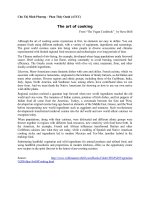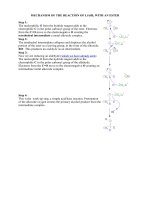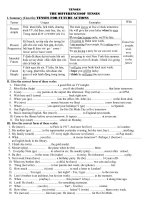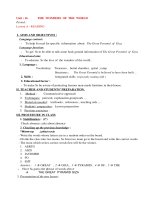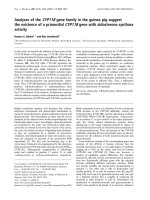- Trang chủ >>
- Sư phạm >>
- Sư phạm văn
The existence of balanced neighborly spheres
Bạn đang xem bản rút gọn của tài liệu. Xem và tải ngay bản đầy đủ của tài liệu tại đây (823.24 KB, 6 trang )
<span class='text_page_counter'>(1)</span><div class='page_container' data-page=1>
TRƯỜNG ĐẠI HỌC HÙNG VƯƠNG
Tập 21, Số 4 (2020): 123-128 Vol. 21, No. 4 (2020): 123-128HUNG VUONG UNIVERSITY
<i>Email: Website: www.hvu.edu.vn</i>
<b>THE EXISTENCE OF BALANCED NEIGHBORLY SPHERES</b>
<b>Nguyen Thi Thanh Tam 1*<sub>, Nguyen Thị Dung</sub>2<sub>, Ha Ngoc Phu</sub>1<sub>, Le Thị Yen</sub>1</b>
<i>1<sub>Faculty of Natural Sciences, Hung Vuong University, Phu Tho </sub></i>
<i>2<sub> Faculty of Basic Science, Thai Nguyen University of Agriculture and Forestry, Thai Nguyen</sub></i>
Received: 22 November 2020; Revised: 23 December 2020; Accepted: 25 December 2020
<b>Abstract</b>
W
e concern to the existence of balanced 2-neighborly 3-spheres. The goal of this article is to describeZheng’s results in constructing a balanced 2-neighborly 3-sphere in detail and prove that if ∆ is a balanced
2-neighborly 3-sphere then its system of parameters is linear.
<b>Keywords:</b><i>Balanced neighborly spheres, balanced complex, linear system of parameters.</i>
<b>1. Introduction</b>
Let ∆ be a simplicial complex on the vertex
set [n] = {1,2....,n}. Thus, ∆ is a nonempty
collection of subsets of [n] satisfying that
<i>F </i>∈ ∆ and G ⊂<i> F imply G </i>∈ ∆. Elements
of ∆ are called facets of ∆ and maximal
faces (under inclusion) are called facets. A
simplicial complex is called k-neighborly if
every subset of vertices of size at most k is the
set of vertices of one of its faces. Neighborly
complexes, especially neighborly polytopes
and spheres are interesting objects to study.
In the seminal work of McMullen [1] and
Stanley [2], it was shown that in the class
of polytopes and simplicial spheres of a
fixed dimension and with a fixed number of
vertices, the cyclic polytope simultaneously
maximizes all the face numbers. The
d-dimensional cyclic polytope is <i>d</i><sub>2</sub>−
neighborly. Since then, many other classes of
neighborly polytopes have been discovered.
We refer to [3] and [4] for examples and
constructions of neighborly polytopes.
Meanwhile, the notion of neighborliness
was extended to other classes of objects.
For instance, neighborly cubical polytopes
were defined and introduced in [5], [6] and
neighborly centrally symmetric polytopes
and spheres were studied in [7] and [9].
</div>
<span class='text_page_counter'>(2)</span><div class='page_container' data-page=2>
of this paper is to describe Zheng’s result
in constructing a balanced 2-neighborly
3-sphere Γ concretely and give a property
about system of parameter of complex Γ.
The structure of this article is organized
as follows. In Section 2, we discuss basic
propertiesof balanced neighborly spheres
and give some examples to illustrate it.
In Section 3, we present how to construct
balanced 2-neighborly 3-sphere and describe
it in detail. And prove that if Γ is a balanced
2-neighborly 3-sphere then system Θ is
a linear system of parameters of K∆ in
Proposition 3.2.
<b>2. Balanced neighborly spheres</b>
In this section we introduce balanced
neighborly sphere and some notations that
will be used throughout this article. We
first recall basic definitions on spheres. The
dimension of a face F ∈ ∆ is dim F = |F| -
1 and the dimension of ∆ is the maximum
dimension of its faces. Faces of dimension 0
are called vertices and faces of dimension 1
are called edges. A map k:[n] → [d] is called
a proper coloring map of ∆, if we have κ(i) ≠
κ(i) for any edge {i, j} ∈ ∆. We say that a (d
- 1) - dimensional simplicial complex ∆ on
[n] is balanced (completely balanced in some
literature) if its graph is d-colorable.
<i><b>Example 2.1. We have</b></i>
dim ∆<sub>1</sub> = 1, dim ∆<sub>2</sub> = 2
Since ∆<sub>1</sub> is 2-colorable and ∆<sub>1</sub> is
3-colorable. So ∆1,∆2 are balanced complex.
<b>Figure 1. Complex C4 and C5</b>
A simplicial complex is pure if all of
its facets (maximal faces) have the same
dimension. The geometric realization of ∆,
|∆| is the union in <sub></sub><i>n</i><sub> over all faces {ui1,...,uij</sub><sub>} </sub>
of ∆ of the convex hull of {ei1,...,eij}, where
{e1,...,en} is the standard basis of <sub></sub><i>n</i><sub>. We </sub>
say that ∆ is it homeomorphic to another
∆ such that |∆| is homeomorphic to T. For a
face F ∈ ∆, the subcomplexes
( ) {
: ,}
<i>lk F</i>∆ = <i>G</i>∈ ∆ <i>F G</i>∪ ∈ ∆ <i>F G</i>∩ = ∅
and
( ) {
:}
</div>
<span class='text_page_counter'>(3)</span><div class='page_container' data-page=3>
that every (d - 2) - dimensional face of ∆
is contained in at most two facets, then the
boundary complex of ∆, ∂∆, consists of all
(d - 2)-dimensional faces that are contained
in exactly one facet, as well as their subsets.
A simplicial complex ∆ is a simplicial
sphere (resp. simplicial ball) if the geometric
realization of ∆ is homeomorphic to a
sphere (resp. ball). The boundary complex
of a simplicial d-ball is a simplicial (d -
1)-sphere. A balanced simplicial complex
is called balanced k-neighborly if every set
of <i>k or fewer vertices with distinct colors </i>
forms a face. The following Lemma plays
an important role in find balanced neighborly
sphere in next section.
Lemma 2.2. [9] Let d > 4. If ∆ is balanced
homology (d - 1)-sphere and <i>Vd</i> =
{
<i>v v v</i>1, ,2 3}
is the set of vertices of color d, then
<i>i</i> <i>j</i>
<i>lk v</i>∆
<i>lk v</i>∆ is a homology (d - 2)-ball forany 1≤ < ≤<i>i j</i> 3<sub>, and </sub>
1
<i>k</i>
<i>i</i>
<i>i</i>
<i>lk v</i>∆
=
is a homology(d - 3)-sphere.
<b>3. The existence of balanced </b>
<b>2-neighborly 3-sphere</b>
In this section, we present how to
construct balanced 2-neighborly 3- sphere
and describe it in detail. Assume that V1 =
{u1; u2; u3; u4;}, V2 = {v1; v2; v3; v4;}, V3 = w1;
<i>w</i>2; w3; w4;} and V4 = {z1; z2; z3; z4;} are the
four color sets of a balanced 3-sphere Γ. Let
1
<i>A C</i>
<i>lk z</i>Γ <i>A</i> <i>C</i>
∂ ∂
=
and 3<i>A C</i>
<i>lk z</i>Γ <i>B</i> <i>C</i>
∂ ∂
=
, whereA, B and C are triangulated 2-balls sharing
the same boundary as shown in Figure 2.
<b>Figure 2. Discs A, B and C (from left to right)</b>
All possible edges that do not appear in A, B and C are shown in Figure 3 as solid red
edges in disc D’. Notice that the dashed edges in D’ are edges in discs A and B, so we
may rearrange the boundary of D by switching the positions of vertices v1 and v2 and then
replacing the edges containing v1 or v2 in ∂<i>D</i>' by the dashed edges. In this way, we obtain a
</div>
<span class='text_page_counter'>(4)</span><div class='page_container' data-page=4>
<b>Figure 3. Left: disc </b><i><b>D’</b></i><b>. Right: disc D obtained after rearranging the boundary of </b><i><b>D’</b></i>
Furthermore, ∂ ⊆<i>D A B</i>
and ∂<i>D</i>divides the sphere<i>A B</i>
<i>A</i> <i>B</i>
∂
∂ into two discs A’ and B’ asshown in Figure 4. Let 2
'
'
<i>A</i> <i>D</i>
<i>lk z</i>Γ <i>A</i> <i>D</i>
∂ ∂
=
and 4'
' .
<i>B</i> <i>D</i>
<i>lk z</i>Γ <i>B</i> <i>C</i>
∂ ∂
=
Since both <i>st z</i>Γ 1
<i>st z</i>Γ 3 =<i>C</i>and <i>st z</i>Γ <sub>2</sub>
(
<i>st z</i>Γ <sub>1</sub>
<i>st z</i>Γ <sub>3</sub>)
=<i>A</i>' are simplicial 2-balls, it follows that3
1 <i>i</i>
<i>i</i>
<i>M</i> <i>st z</i>Γ
=
=
<sub> is a </sub>simplicial 3-ball. Furthermore, the boundary of M is exactly lkΓ<i>z4. Hence </i>Γ =<i>M</i>
<i>st z</i>Γ 4 isindeed a balanced 2-neighborly 3-sphere.
</div>
<span class='text_page_counter'>(5)</span><div class='page_container' data-page=5>
Let ∆ be a (d - 1)-dimensional balanced simplicial complex on [n] and let R =
<i>K[x</i>1,..., <i>xnbe a polynomial ring over an infinite field K. The ring K[</i>∆] = <i>R/I</i>∆, where
[ ]
| ,
<i>i</i>
<i>i F</i>
<i>I</i>∆ <i>x F</i> <i>n F</i>
∈
=<sub></sub> ⊂ ∉ ∆<sub></sub>
∏
, is called the Stanley-Reisner ring of ∆.<i><b>Example 3.1. Consider complex ∆</b></i><b>1</b><i><b> and ∆</b></i><b>2</b><i><b> as Figure 1. We have</b></i>
(
)
1 1, , ,3 2 4
<i>I</i>∆ = <i>x x x x</i> , dim<i>K</i>
[ ]
∆ =1 2(
)
2 1, ,3 1 4, 3 5, 2 3 4
<i>I</i>∆ = <i>x x x x x x x x x</i> , dim K[∆<sub>2</sub>]=3
Set Vk = {v ∈<i> [n]|k(v) = k}. Let </i> <i>k</i>
<i>k</i>
<i>k</i> <i>v</i>
<i>v V</i>
<i>x</i>
θ
∈
=
∑
<sub>, for k = 1,2,...,d. Then </sub><sub>Θ = θ</sub><sub>1</sub><sub>,...,θ</sub><i><sub>d is a system </sub></i>of parameters of K[∆] = <i>R/I</i>∆. The Krull dimension of K[∆] is the minimal number k such that
there is a sequence θ1,...,θ<i>k </i>∈<i> R of linear forms such that dimk K[</i>∆]/(Θ)<∞. It is well-known
that the Krull dimension of K[∆] equals dim ∆ +1 ([10], II Theorem 1.3). If K[∆] is of Krull
dimension d, then a sequence Θ of linear forms such that dimk K[∆]/(Θ)<∞ is called a linear
system of parameters (l.s.o.p. for short) of K[∆]. Therefore, we have the following property.
Proposition 3.2. If Γ is a balanced 2-neighborly 3-sphere then Θ is a linear system of
parameters of K[∆].
Proof. We see that dimk K[Γ] = 4 and
{
<i>z z</i>1 2 <i>z z u u u u v v v v</i>3 4, 1 2 3 4, 1 2 3 4, w w1 2 w3 w4}
Θ = + + + + + + + + + + + + .
</div>
<span class='text_page_counter'>(6)</span><div class='page_container' data-page=6>
<b>4. Conclusions</b>
The main result of the article is to describe
Zheng’s result in constructing a balanced
2-neighborly 3-sphere in detail and prove
that if ∆ is a balanced 2-neighborly 3-sphere
then its system of parameters is linear.
<b>References</b>
[1] McMullen P. (1970). The maximum numbers
of faces of a convex polytope. Journal
Mathematika, 17, 179-184.
[2] Stanley R. P. (1975). The upper bound
Conjecture and Cohen-Macaulay ring. Studies
in Applied Mathematics. Vol. LIV, 2.
[3] Shermer I. (1982). Neighborly polytopes. Israel
Journal of Mathematics, 43, 291-314.
[4] Padrol A. (2013). Many neighborly polytopes
and oriented matroids. Discrete Comput. Geom.,
50, 865-902.
[5] Joswig M. & Ziegler G. M. (2000). Neighborly
cubical polytopes. Discrete & Computational
Geometry. 24(2), 325-344.
[6] Joswig M. & Rorig T. (2007). Neighborly
cubical polytopes and spheres. Israel Journal of
Mathematics, 159, 221-242.
[7] Burton G. (1991). The non-neighbourliness of
centrally symmetric convex polytopes having
many vertices. Journal of Combinatorial,
Theory Series, A 58, 321-322.
[8] Jockusch W. (1995). An infinite family of nearly
neighborly centrally symmetric 3-spheres.
Journal of Combinatorial. Theory Series, A 72,
318-321.
[9] Zheng H. (2020). Ear Decomposition and
Balanced 2-neighborly Simplicial Manifolds.
The Electronic Journal of Cominatorics, 27, 1.
[10] Stanley R. P. (1996). Combinatorics and
Commutative Algebra. Second Edition,
Birkh<i>ä</i>user, Auser, Boston, Basel, Berlin.
<b>SỰ TỒN TẠI CỦA CẦU CÂN BẰNG NEIGHBORLY</b>
<b>Nguyễn Thị Thanh Tâm 1*<sub>, Nguyễn Thị Dung</sub>2<sub>, Hà Ngọc Phú</sub>1<sub>, Lê Thị Yến</sub>1</b>
<i>1<sub>Khoa Khoa học tự nhiên, Trường Đại học Hùng Vương, Phú Thọ</sub></i>
2 <i><sub>Khoa</sub><sub> Khoa học cơ bản, Trường Đại học Nơng Lâm Thái Ngun, Thái Ngun</sub></i>
<b>Tóm tắt</b>
C
húng tơi quan tâm đến sự tồn tại của cầu đơn hình cân bằng neighborly. Mục tiêu của bài báo là mô tả mộtkết quả của H. Zheng về việc xây dựng một 3-cầu cân bằng 2-neighborly một cách chi tiết và chứng minh
rằng nếu Γ là 3 cầu cân bằng 2-neighborly thì hệ tham số của nó là tuyến tính.
</div>
<!--links-->
